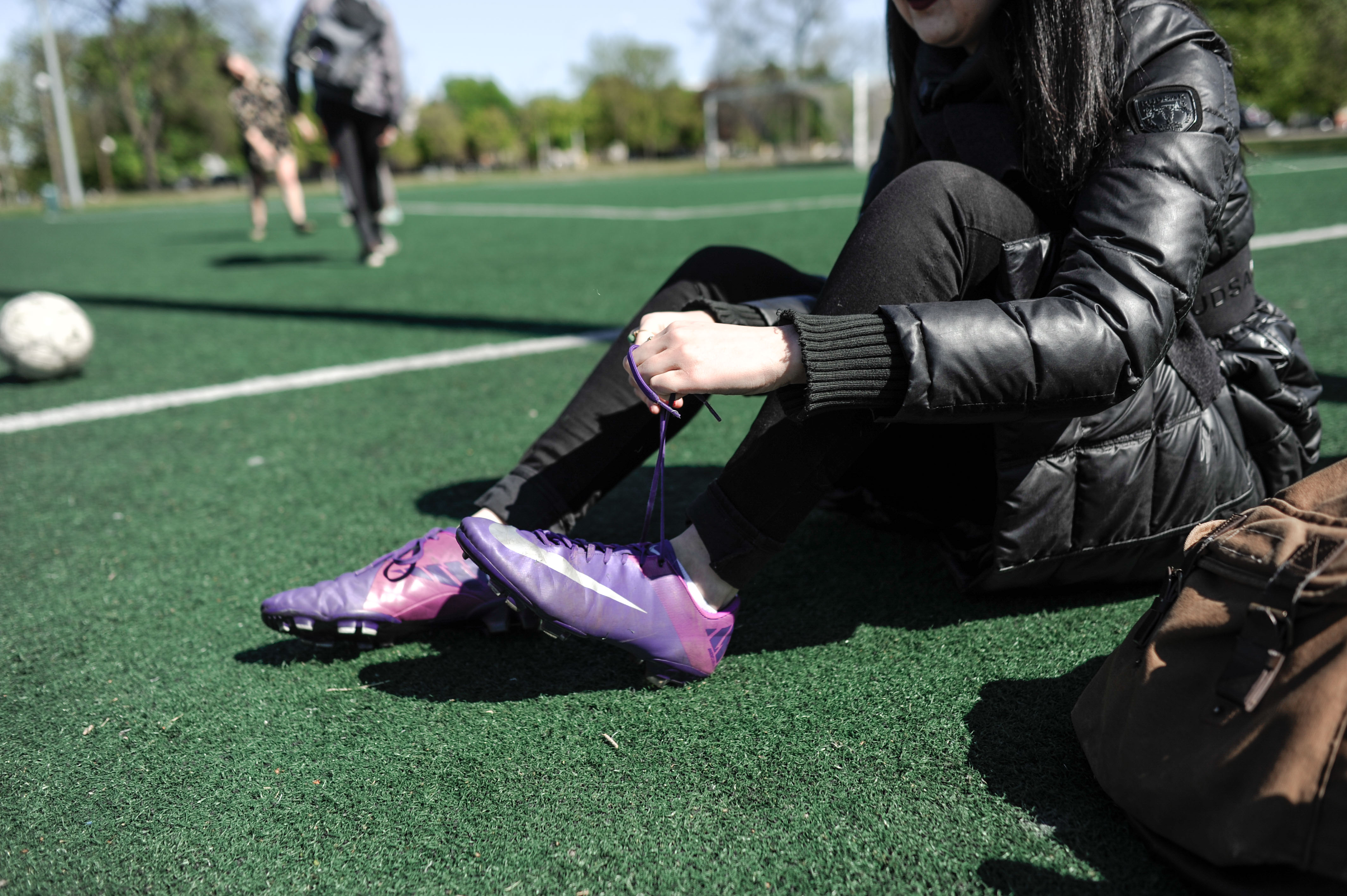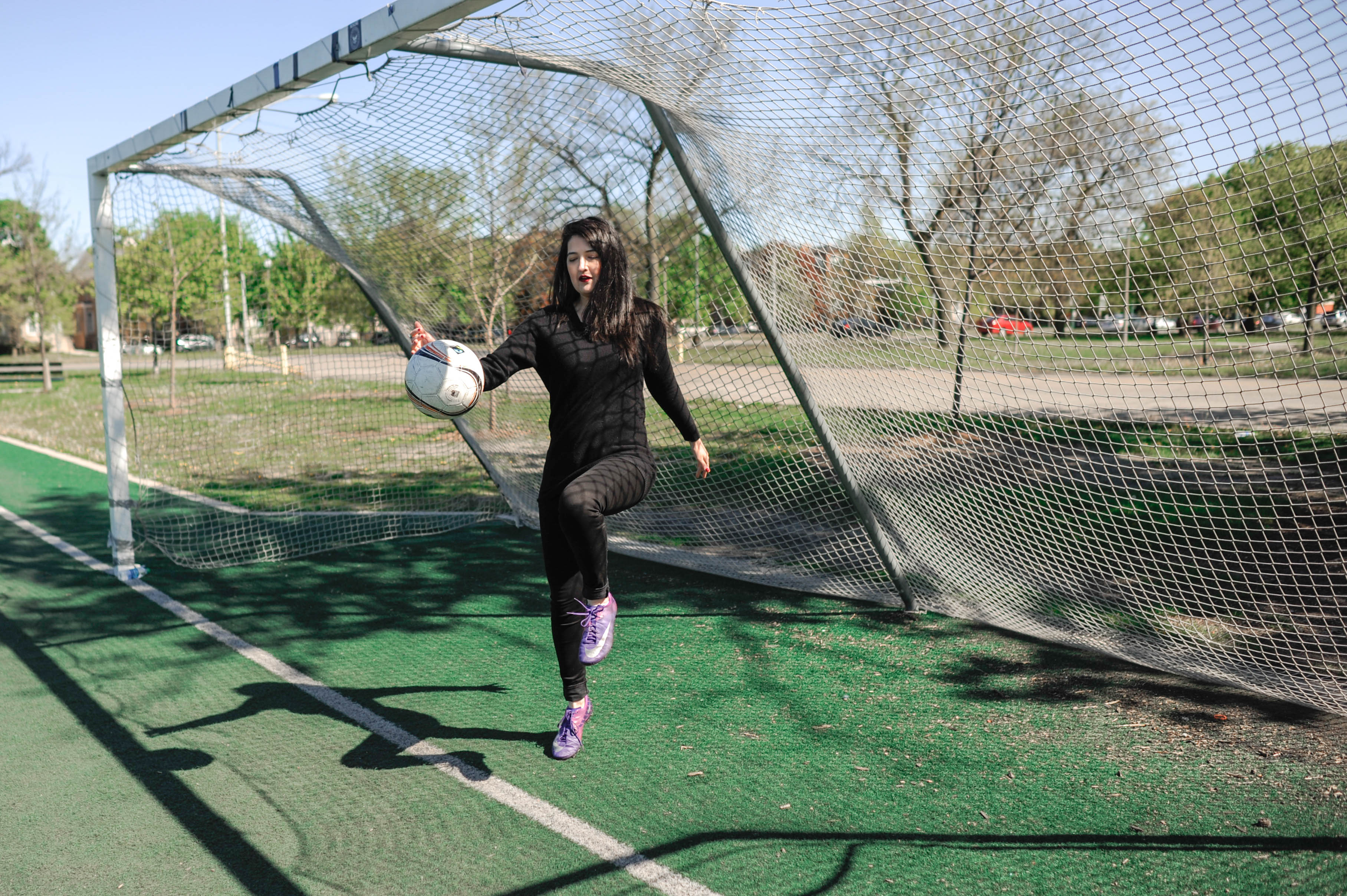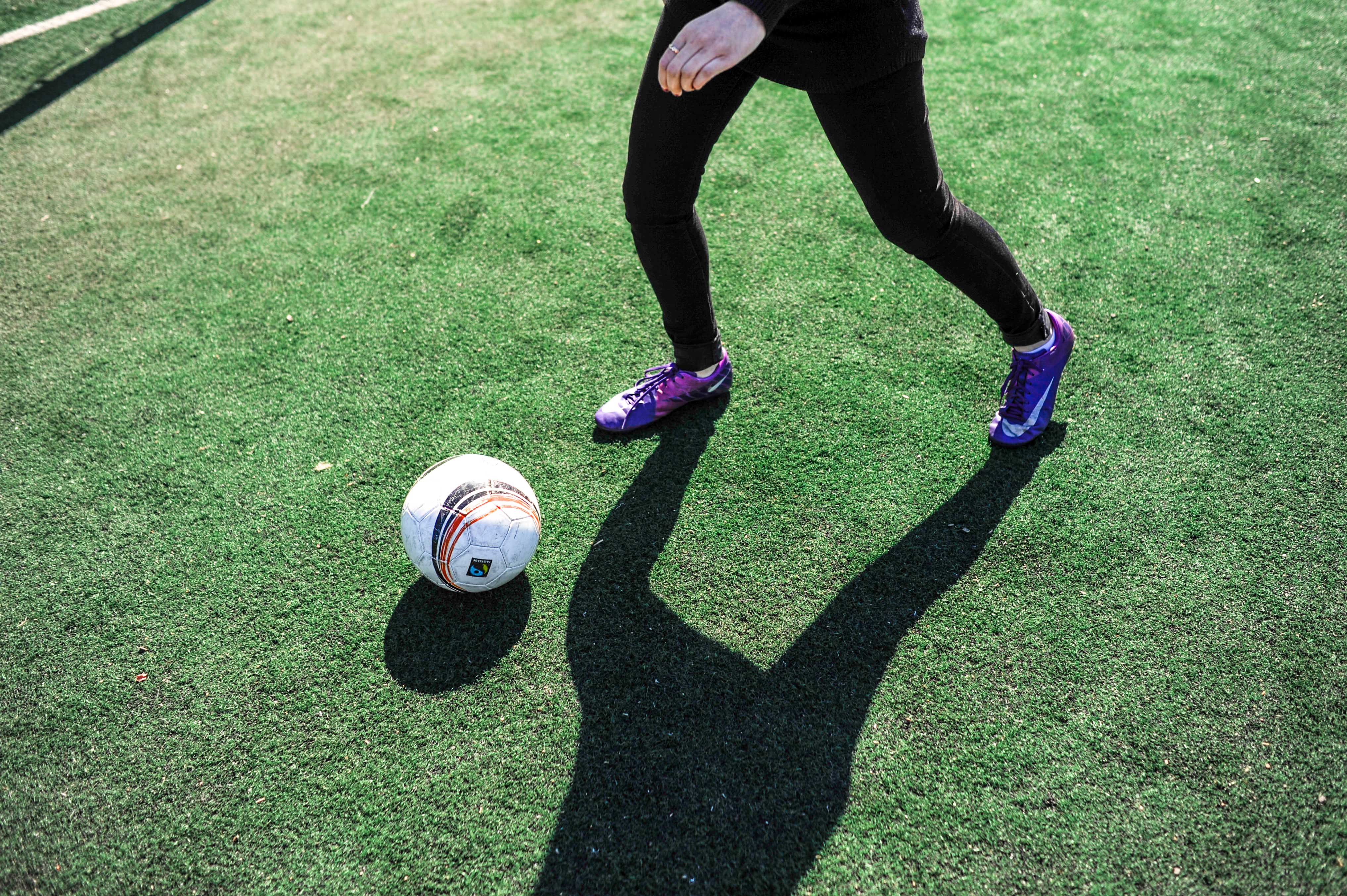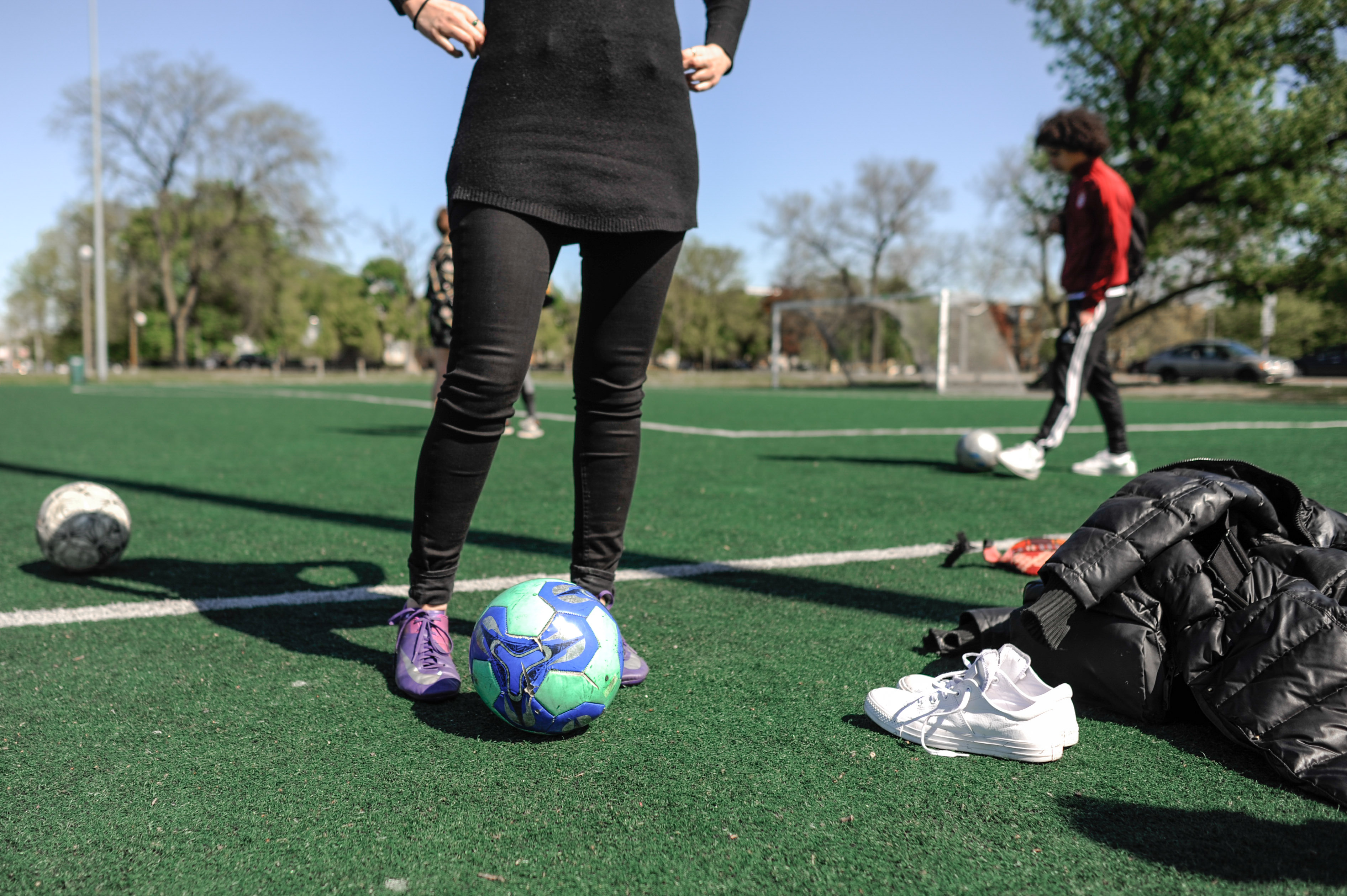Like many cities in the United States, access to jobs, bank loans, and access to public space in Chicago is determined by class, race, gender identity, and sexuality. That formula plays out in sports, too, shaping the geographic and social boundaries of soccer’s infrastructure in the city.
It’s fair to say that soccer is humanity’s only truly global sport, but that doesn’t mean that the game is inherently accessible for all who want to play. From the highest levels of soccer–those played on the pristine pitches of Europe–to a neighborhood park on Chicago’s Southwest Side, there continue to be barriers of racism, sexism, and discrimination that keep soccer from being the inclusive, worldwide sport its supporters want it to be.
Soccer–as it’s called in the United States (and nowhere else)–is growing rapidly across the country: according to a 2016 Nielsen Scarborough survey, almost 16 million people in the U.S play soccer, professionally or informally, growing from 11 million in 2009. The variables that contribute to its mass appeal are easy to distinguish. All you need to play is a ball (composed of virtually any material), a flat surface (of any size), and a goal.

The game’s continued growth seems inevitable. The concern is whether everyone that wants to play soccer will get equal footing on the pitch or not. One of the pitfalls of rapid growth may be that it leads to a homogenous style of play where some players excel and others get pushed out. It’s almost guaranteed you could drop into any pick up game and find mostly young men emulating a trick or a shot performed by their cis-male soccer hero of choice on some grand stage the night before. People reproduce patterns and behaviors.
With the advancing commodification of soccer, images of fútbol fantasy become ubiquitous and all-consuming. Advertisements promote cis-gender body-types and individualistic playing styles that become the dominant mold for aspiring players. If the meteoric growth of soccer is partially rooted in the capitalist dance between the entertainment and gender norms, can we expect room to be made for those that don’t fit the mold?
The concern is whether everyone that wants to play soccer will get equal footing on the pitch or not.
Jasmin Pizano Luna, 21, grew up playing soccer in the Back of the Yards neighborhood in Chicago. She was talented enough to play against older, more experienced players, but most boys would still exclude her from pick up games. On the rare occasions they let her join, the ball would hardly be passed to her.
In her neighborhood, young people would play soccer all the time, but that didn’t mean everyone has access to play. She says young women learn the difference early on. “It’s hard to separate playing soccer and being a girl,” she said. “As a girl, I have to prove myself as a good player first.”
Pizano Luna was raised in a working class family that struggled to pay for her soccer club team fees, uniforms, soccer shoes or training sessions. “I would look online for training events, but if I knew the cost wouldn’t be feasible I just wouldn’t ask [my family],” she said. “I do believe they know I would’ve loved to be on a traveling team or go to training camps.”
In her sophomore year of high school, she got her chance to attend a training camp. The school’s soccer coach raised the funds to send Pizano Luna and several of her teammates to a week-long training camp at the University of Notre Dame, in South Bend, Indiana.
“I think [my coach] did that because she knew we wouldn’t have been able to access that kind of training without financial support,” she said. Pizano Luna was one of only a few Latinas at the camp. She marveled at the “fancy shoes and gear” that other campers–mostly young, white girls–were decked out in.
“I saw the major differences between income levels for different girls,” she said.

Soccer, at its best, is a sport that epitomizes collectivism and solidarity; a group of people work together to achieve (or score) a goal that benefits them all. When soccer centers on individual skill, instead of combined skill, or elevates the significance of winning, the importance of solidarity arguably becomes outweighed by practices that align with individualism.
Northwestern graduate student Claudia Garcia-Rojas joined Chicago Soccer for Justice (CSFJ) to be part of a soccer community that worked to create a space that welcomed all bodies and challenge oppressive dynamics in sports. Garcia-Rojas, who is also the co-director of the Chicago Taskforce on Violence Against Girls and Young Women, says the group was a “primarily people of color-centered group of activists and organizers that met regularly to cultivate community and a culture of resistance by playing the world’s game: fútbol.”
CSFJ played the game differently from other soccer teams. If a person was highly skilled, they would create space for less-skilled players to take leadership on the field in order for them to develop skill sets.
“Sports reflect how we put into practice our most valued theories of justice, liberty and even love.”
Of course, no space is truly “safe,” not even one that is organized by people groups that center social justice principles. As is almost unavoidable when people from diverse sets of experiences play contact sports, challenges arose around gender, race, ability, and class. People do their best to set intentions and hold themselves to account. CSFJ members took time to address issues together as they arose.
“I think sports reflect the broader social interplay between theory and practice,” Garcia-Rojas said. “Sports reflect how we put into practice our most valued theories of justice, liberty and even love.”
While CSFJ is no longer active, their work directly informed and inspired new groups in Chicago. One such group is called Left Wing Futbol – Xicago, a collective that organizes community soccer games where people of all ages, all skill levels, and all body presentations play soccer.
Maritere Gomez, 29, grew up playing organized soccer at Gage Park on Chicago’s Southwest Side, but in her years working as an activist, she struggled to find soccer spaces that welcomed a wide spectrum of people, especially queer people and leftists. That’s why she has been a member of Left Wing since it launched in Chicago in 2014. Gomez, a self-described queer and working poor Latina, said she stopped playing co-ed soccer because she was frustrated with men who would “show off their skills and take up too much literal space” in matches.
At Left Wing’s Sunday soccer meet ups in Chicago’s Pilsen neighborhood, people are challenged to rethink how they play the game. The score is always 2 to 2, no matter how many goals are scored, and everyone cheers on every goal and every player. Gomez said Left Wing works to center queer, working class people of color and trans athletes–people who traditionally aren’t represented in the sport.
For example, on April 30th, the group hosted a game they called “Womyn, Trans, and Gender Non-Conforming Soccer” at Harrison Park in Pilsen, a Latinx community on the Southwest Side. “Around the city, spaces for playing soccer are dominated by toxic, hyper-masculine energy,” she said. “[Left Wing] represents a kind of resistance space for people who have traditionally been pushed out from soccer spaces.”

In Chicago, struggling to pay league fees or pay for field rental are other ways athletes, specifically those living in poverty, can be pushed out of the game. For Gomez, eliminating financial barriers to soccer had to be a central pillar for Left Wing. She remembers being priced out of soccer training camps when she was in high school. Her dad was a yardero. Her mom worked at a factory. Soccer became an expensive luxury.
“It wasn’t about the sport anymore,” she said. “It was about affordability, about money, and your place in the economic ladder.”
If you’ve ever signed up to join a sports league, you know that you can typically only sign up for an all-male, all-female, or a coed team. These categories reinforce the gender binary that excludes the galaxy of complex identities and body presentations that complicate normative ideas about gender.
A 2010 report called Equal Opportunity For Trans Student Athletes laid out strategies and best practices for institutions working to create inclusive, safer spaces for people excluded from sports: trans athletes. The report cautions adopting policies that can harm trans people, such as the eligibility clause for transgender athletes developed by the International Olympic Committee, which requires any trans athlete taking part in Olympic events to have had genital reconstructive surgery before being selected for competition.
Spaces where trans people exclusively can come together to play soccer are rare.
“Most transgender people—even as adults—do not have genital reconstructive surgery,” the report states. “Whether a transgender person has genital reconstructive surgery has no bearing on their athletic ability.” It also explained that “transgender” describes an individual whose gender identity (one’s internal psychological identification as a boy/man or girl/woman) does not match the person’s sex at birth.
For their part, the U.S Soccer Federation’s organizational bylaws make it clear that there can be no organized soccer space that excludes people based on race, class, sex, or national origin. However, there is no distinction made between gender and sex.
In Chicago, there are dozens of athletic organizations dedicated to organizing and publicizing events for LGBTQIA sports. Organizations like Chicago Midwest Sports Association and Athletic Alliance of Chicago are among the most active in the city.
Still, spaces where trans people exclusively can come together to play soccer are rare.
Everett Dietzler, 34, knows all too well about the lack of trans-friendly athletic spaces. Around the summer of 2012, he decided to change that by building a space for trans people to meet up and play in Humboldt Park, a park on Chicago’s Westside. Dietzler says the gathering began with the intention of being a space centering trans-people because that doesn’t really exist in sports. It didn’t matter how good you were at the sport. “We were pretty lax on the rules,” he said. “It was about engaging with others. If someone didn’t like a certain aspect of the game we would address it together.”
Having a trans-centered space gave the group an opportunity to engage with each other differently as trans people, Dietzler said. Many of them were used to having heavy conversations or intense experiences together. “It was a space to release,” he said, “a space to engage in community in a lighter way, especially one that wasn’t tied to bar culture.”
Inclusion is about solidarity and “making space for people across the gender spectrum.”
Dietzler says he has always been athletic but never felt truly comfortable signing up for recreational teams. It’s not an issue of availability of options. He says he would feel anxious playing on a team of entirely cis-gender players, even if some or all of the players were queer. For trans athletes, there is a feeling of anxiety around passing or not passing–as a man or woman–on a cis-gender team. Some transgender people choose to share the fact that they are transgender with others. Others prefer to keep those details private.
If a movement of athletes and fans wants to make soccer more inclusive, they should center trans people and their experiences, especially in a sport that has historically excluded trans people. That doesn’t mean cis-gender athletes should paternalistically determine what a “safe space” looks like in soccer, or hold space out of pity or charity. For Dietzler, inclusion is about solidarity and “making space for people across the gender spectrum.”

Soccer is played in poor and rich countries. It is played under dictatorships and democracies. Players fall on along the full spectrum of race, gender presentation, political affiliation and economic status. FIFA, the sport’s global governing body has more member states than the United Nations.
Undoubtedly, the game will continue to grow, especially with advancements in entertainment technology and the rapid expansion of domestic leagues like Major League Soccer. But what is the value of soccer’s growth if the game (and the stadiums that host it) become less inclusive over time?
Society’s most oppressive behaviors and toxic rhetoric are often amplified at athletic events. Garcia-Rojas says fans and athletes can disrupt that tradition.
Society’s most oppressive behaviors and toxic rhetoric are often amplified at athletic events. Garcia-Rojas says fans and athletes can disrupt that tradition, using stadiums and pitches as platforms to engage in different forms of activism, including showing solidarity with movements for justice.
“[Athletes] can leverage their power – by kneeling or speaking out or suspending activities – to draw national attention to issues we otherwise would not be talking about,” she said. “They can help illuminate the shared oppressive practices and politics that exist across different social institutions.”
In a game with one of the lowest barriers for entry, in terms of equipment needs, there is a glass ceiling for athletes that diverge from the construct of an archetypal soccer player. Low income athletes of color navigate a soccer meritocracy wherein players are treated like commodities in a marketplace, pushed through a gauntlet that uses a rigid calculus to determine value. Female players face sexism, and, when they reach their professional peak, face the prospect of low wages and a playing career that is not on par with the prestige and economic stability that one can find in men’s soccer. Trans athletes are marginalized and, in many ways, made invisible by glaringly harmful and transphobic policies.
A “pay-to-play” system within soccer’s youth development leagues privileges athletes that come from wealthy or more well-off families. Given the country’s history of inequitable wealth distribution and racist capitalism, it’s no surprise that the athletes who are able to access the necessary tools and opportunities to rise to the top tend to be white.
For example, the U.S Women’s team won the World Cup, the global soccer competition that takes place every four years, in 2015. Amid the praise and jubilation for this key moment in women’s sports history, some were critical of the fact that the U.S national team players were almost all white.
For her part, Pizano Luna still plays when she can, often with Left Wing Xicago, though she carries the weight of mixed emotions; joy and cautious optimism. Even if the national teams are made up predominantly of white players, she feels hopeful that soccer can become more inclusive and equitable on the national and local levels.
“Yes, they are white and money still rules but I think there is talent everywhere,” she said. “I think this talent will find ways to show itself. Things will get better.”







